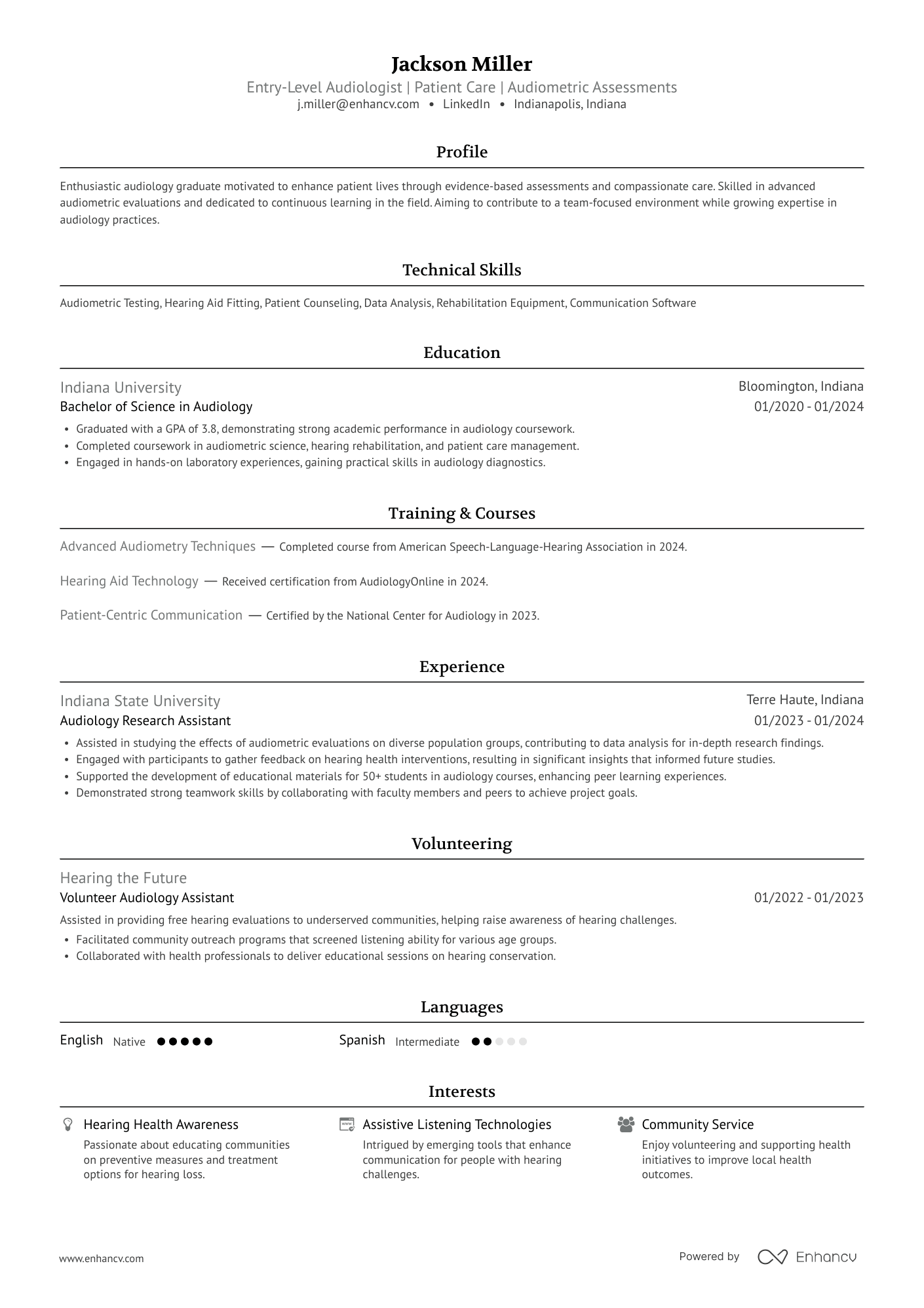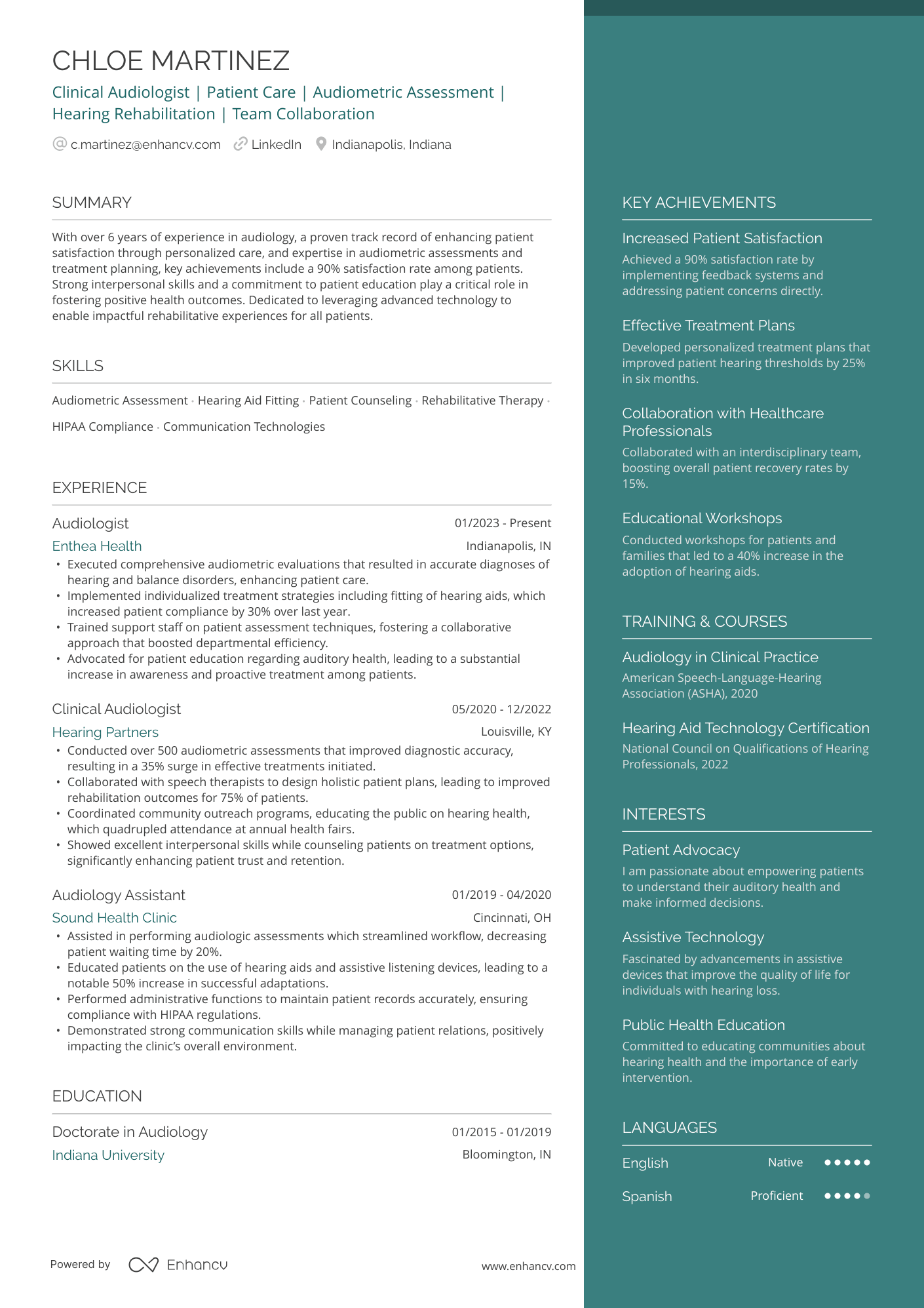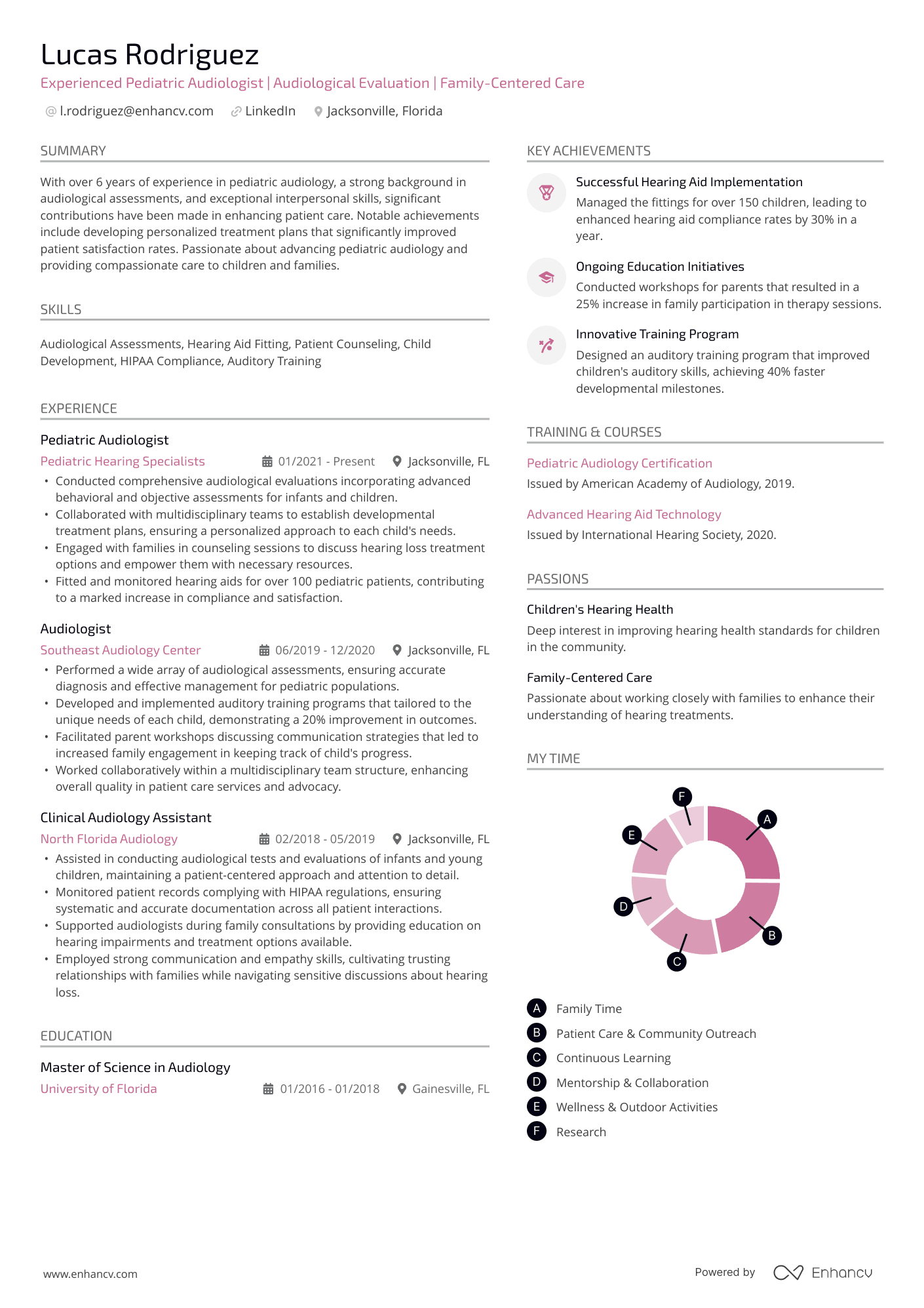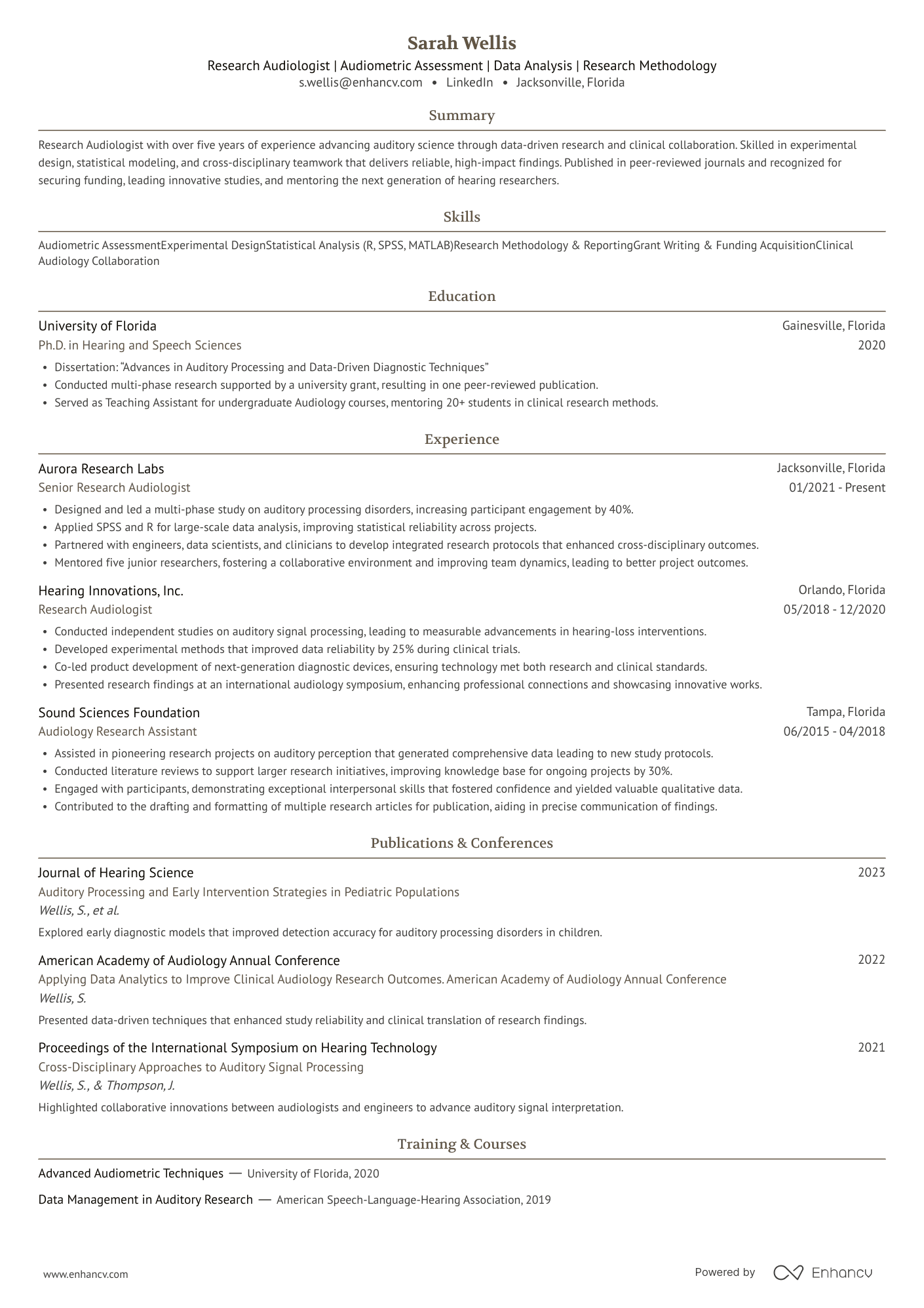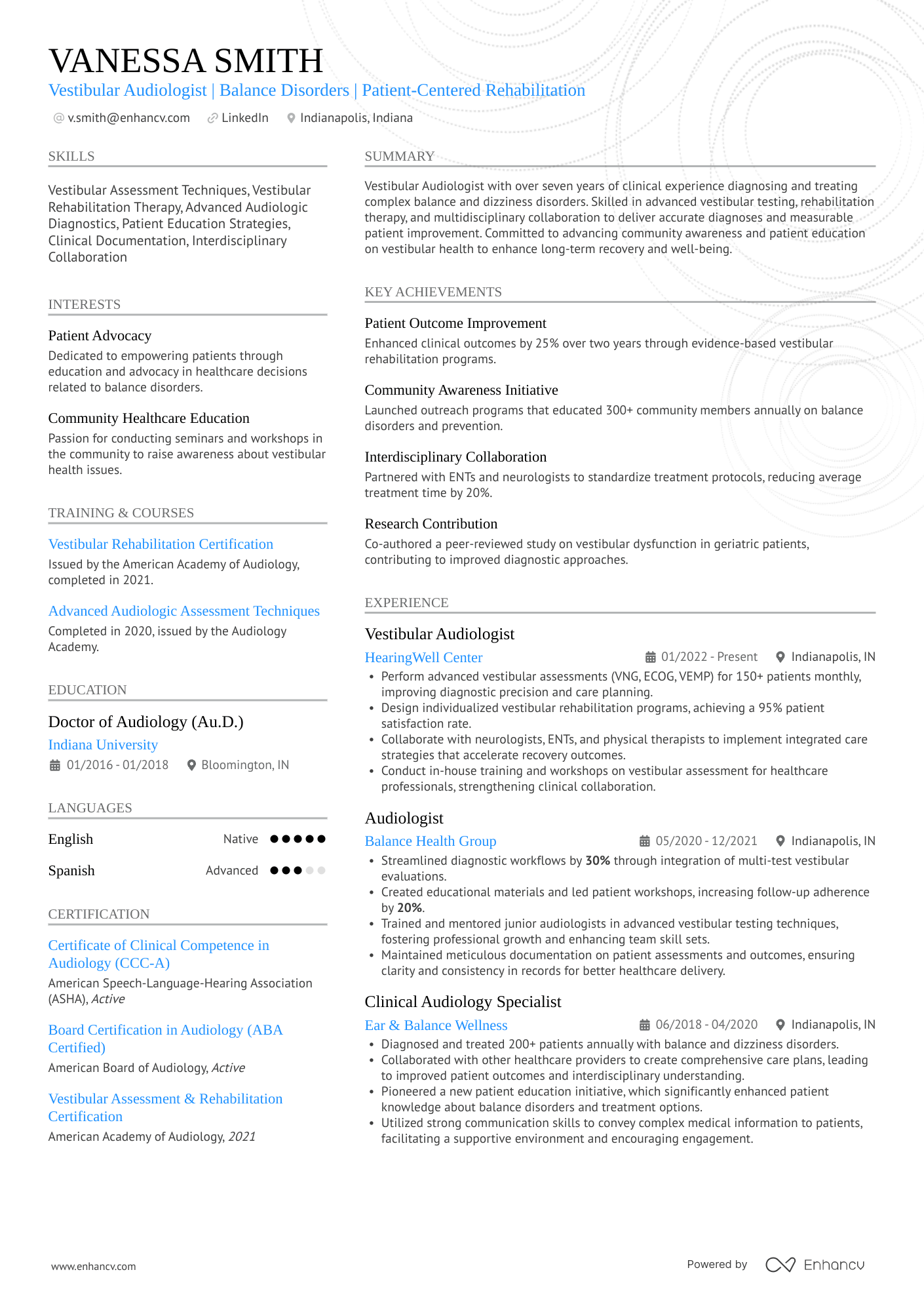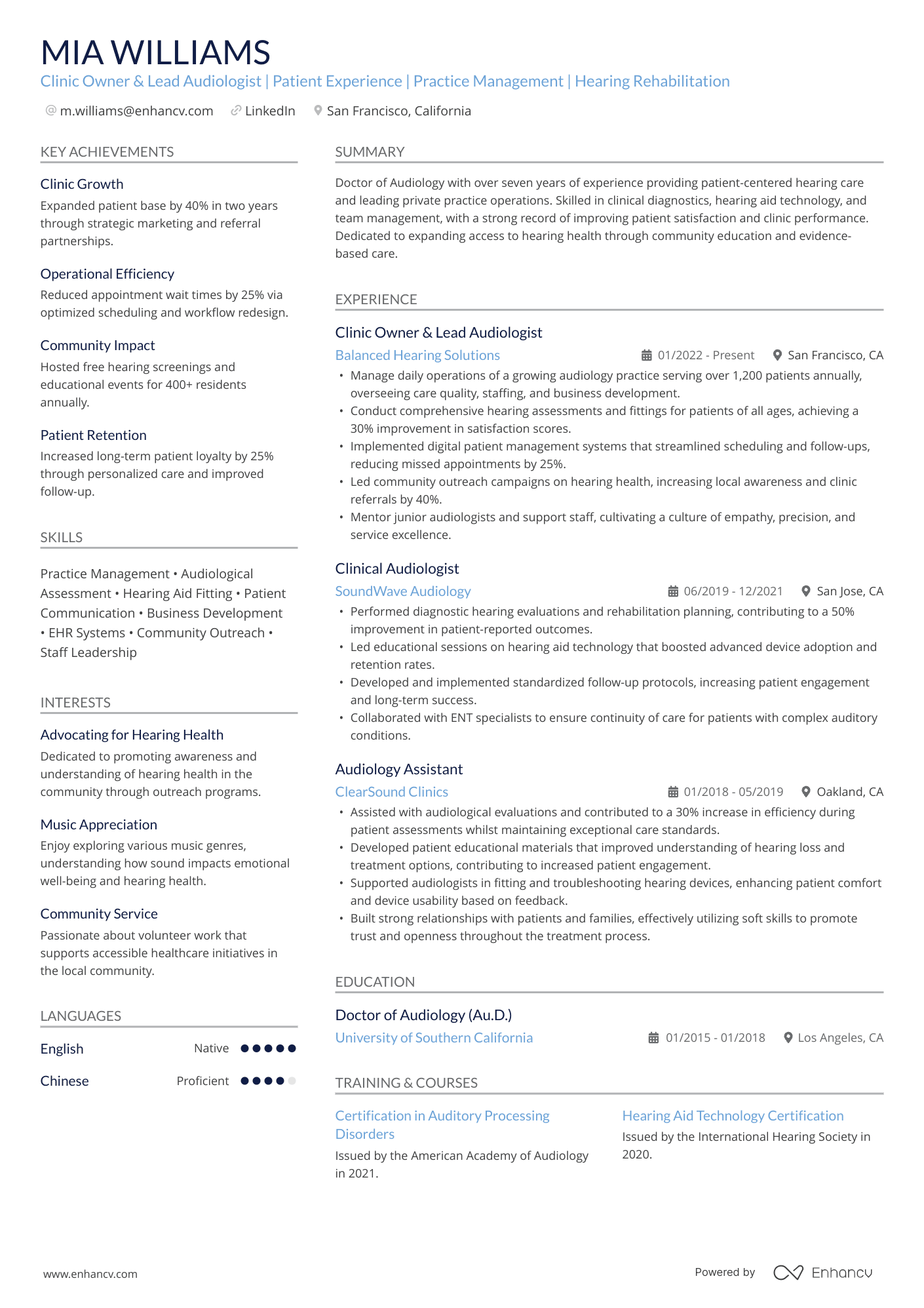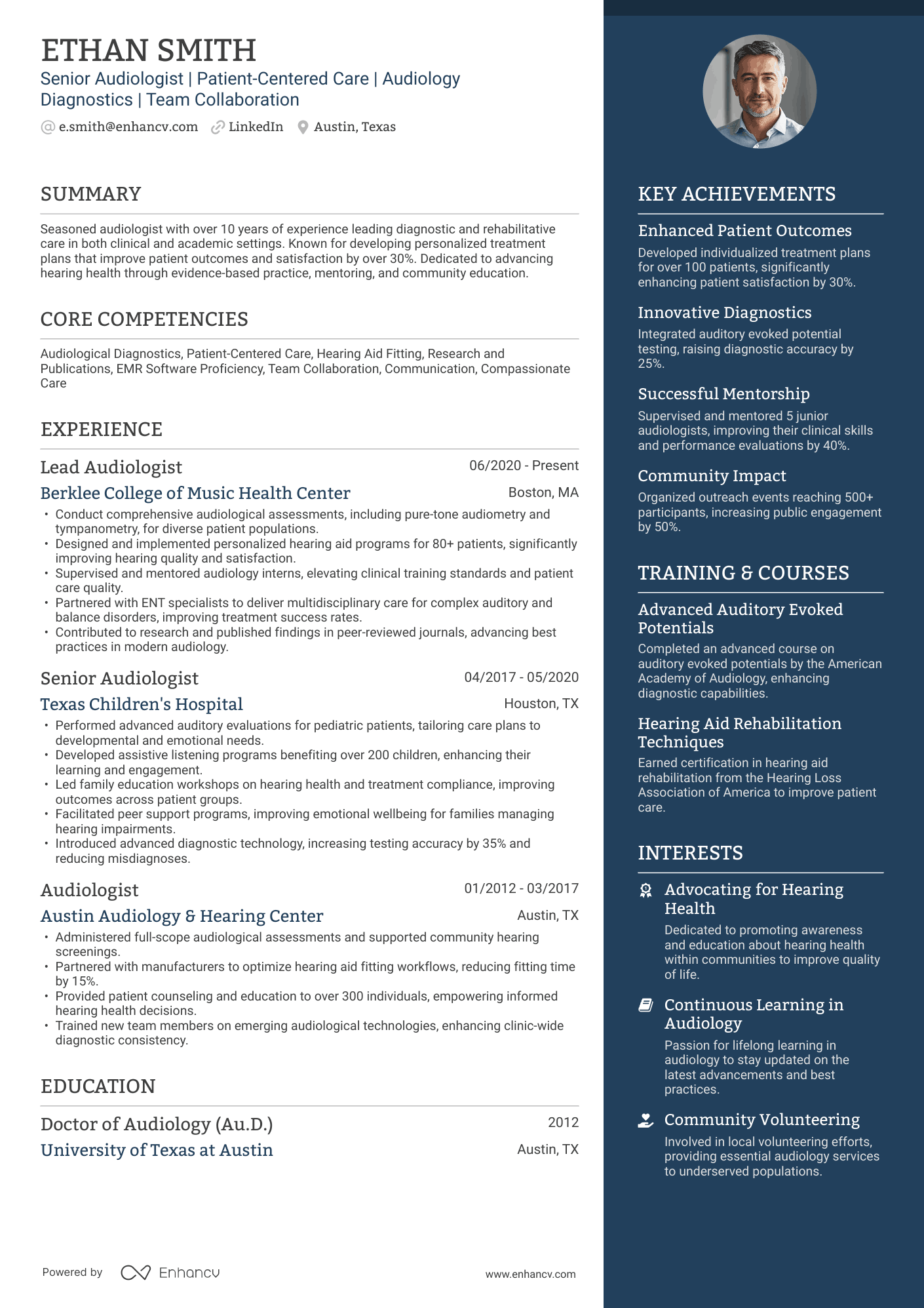On the surface, audiology is about testing hearing. But in reality, it’s much more—it’s helping people reconnect with the world around them. That’s why your resume should focus on compassion, along with your technical skills and the impact of your work.
Quantifiable results help, but recruiters also want proof of patient care excellence and empathy.
At Enhancv, we’ve helped thousands of audiologists create resumes that highlight both compassion and competence. Use these audiologist examples, templates, and tips to help you stand out in 2026 and land your next role in hearing healthcare.
Key takeaways
- A strong audiologist resume blends clinical expertise with compassion, showing both skill and patient impact.
- Use a reverse-chronological format and keep it to one page unless you have extensive experience or research work.
- Highlight measurable results—like higher satisfaction rates or efficiency gains—to make your impact clear.
- Combine technical and interpersonal skills to demonstrate balanced, patient-centered care.
- Include your Au.D., licensure, and certifications to reinforce credibility and professional standards.
- Use Enhancv’s ATS Resume Builder to create a patient-focused, results-driven audiologist resume that stands out in 2026.
Next, see examples from hospitals and clinics, plus how to showcase a similar impact on your resume.
Customize these audiologist resumes
By Experience
Entry-Level Audiologist
Senior Audiologist
By Role
Clinical Audiologist
Pediatric Audiologist
Research Audiologist
Vestibular Audiologist
Private Practice Audiologist
How to choose the best audiologist resume format
A strong audiology resume is about balancing clinical expertise with compassionate care. Your credentials—accurate diagnostics and successful outcomes—matter just as much as your ability to foster trust and collaborate within teams. The best resume format helps recruiters quickly recognize that balance and understand the lasting impact you make in patients’ lives.
Which resume format should an audiologist use?
The reverse-chronological format is the best choice for audiologists. It highlights your clinical experience and professional growth in a clear, logical order—starting with your most recent role.
For most audiologists, a one-page resume is ideal—especially if you have under ten years of experience. Senior clinicians with research or leadership can use two pages to show depth without clutter.
PRO TIP
A two-column layout works well for most audiologists—it gives equal prominence to clinical expertise and patient-centered qualities. It’s ideal for private practices, clinics, and healthcare organizations that value a polished, contemporary look.
A single-column layout offers a more traditional presentation and is often preferred in academic or hospital settings, where clarity and straightforward structure take priority.
What sections should go on an audiologist resume?
With your format in place, let’s see what to include on your audiologist resume.
- Header (name, contact info, location, LinkedIn)
- Professional Summary
- Experience
- Education
- Key Achievements
- Skills
- Certifications & Training
- Professional Memberships (optional)
- Volunteer Work (optional)
Before you continue, see how your current resume performs—run it through our free ATS Checker.
Is your resume good enough?
Drop your resume here or choose a file. PDF & DOCX only. Max 2MB file size.
How to write your audiologist resume experience
Use your experience section to show impact: improved hearing, teamwork, and higher care standards. Recruiters want to see clear examples of your work and get a sense of your character and patient approach.
Start this section with a clear heading, such as “Experience” or “Professional Experience.” If you’re early in your career or completing a residency, you can also use “Clinical Experience.” Choose whichever best reflects your background and the setting you’ve worked in, but steer clear of vague wording that may confuse the recruiter.
These elements should structure your experience entries:
- Job title and facility name: Clearly state your position and setting—whether you worked as a Clinical Audiologist, Pediatric Audiologist, or Hearing Care Specialist in a hospital, private clinic, or research environment.
- Dates of employment: Keep formatting consistent so your career progression is easy to follow. You can include both the month and year for each role, or list just the start and end years.
- Location: Optional, but helpful for context (city and state are enough).
Then, show what you’ve done using three to six bullet points that highlight:
- Scope of practice: Types of patients or disorders you treated, and the volume of evaluations or fittings performed.
- Clinical expertise: Tools, techniques, or technologies used for diagnostics and rehabilitation.
- Collaboration: How you worked with ENT specialists, speech-language pathologists, or multidisciplinary teams.
- Patient outcomes: Improvements in satisfaction, hearing ability, or treatment adherence.
- Operational improvements: Ways you’ve enhanced clinic efficiency, reduced wait times, or supported team workflows.
You can rely on Enhancv’s Bullet Point Generator to help you with your content.
Let’s look at an example.
Good example of an audiologist experience section
Audiologist
American Hearing & Audiology — Philadelphia, PA
January 2021-Present
- Conduct comprehensive audiological evaluations for patients of all ages, diagnosing and managing hearing and balance disorders.
- Developed and implemented individualized treatment plans, resulting in a 25% improvement in patient outcomes within six months.
- Fit, program, and verify hearing aids using real-ear measurement techniques to ensure optimal performance and comfort.
- Collaborate with ENT specialists and primary care providers to coordinate holistic treatment strategies.
- Led a clinic workflow improvement project that reduced average patient wait time by 15 minutes and improved daily scheduling efficiency.
Clinical Audiologist
Hearing Health Solutions — Philadelphia, PA
June 2018 – December 2020
- Provided rehabilitative audiology services, including hearing aid fittings and follow-up care, maintaining a 95% patient satisfaction rate.
- Delivered patient education seminars that increased awareness of hearing loss prevention and boosted engagement by 30%.
- Partnered with local physicians to streamline referral processes, resulting in a 40% rise in new patient visits.
- Maintained precise patient documentation in compliance with state and federal healthcare standards.
How to tailor your audiologist resume experience
Tailoring your resume isn’t about rewriting your story completely each time—it’s about aligning your achievements with what the role prioritizes.
Recruiters—and the applicant tracking software—compare your experience with the job description. Including the right keywords ensures your document passes initial filters and speaks the same language as the hiring team.
Here are several ways to tailor your audiologist experience section:
- Match the patient groups mentioned in the posting (pediatric, geriatric, vestibular, cochlear implant, etc.).
- Reference the audiology tools or software listed (e.g., Otosuite, AudBase, GSI, Noah).
- Highlight the work environment—hospital, private clinic, academic setting, or teleaudiology.
- Mirror the employer’s core values, such as “patient-centered care,” “collaboration,” or “evidence-based practice.”
- Emphasize quantifiable outcomes that align with their goals, like improved patient satisfaction, reduced waiting times, or successful hearing aid fittings.
Use Enhancv’s One-Click Tailoring to effectively match your resume to the job description. Look at the examples we created with it below.
Resume tailoring examples for audiologists
| Job description excerpt | Untailored bullet | Tailored bullet |
|---|---|---|
| Experience providing diagnostic evaluations and patient counseling in a fast-paced ENT clinic. | Performed audiological assessments for patients. | Conducted diagnostic evaluations and provided patient counseling for over 25 daily appointments in a busy ENT clinic. |
| Skilled in hearing aid fitting, verification, and patient follow-up. | Fit and adjusted hearing aids for patients. | Fit, programmed, and verified hearing aids using real-ear measurements, achieving a 95% patient satisfaction rate. |
| Collaborate with multidisciplinary teams to develop comprehensive treatment plans. | Worked with other healthcare professionals. | Collaborated with ENT physicians and speech-language pathologists to design individualized care plans for complex cases. |
How to quantify your experience on an audiologist resume
Audiology isn’t a profession built around numbers—it’s about patient relationships and life-changing outcomes that aren’t always easy to measure. Still, when used thoughtfully, data helps illustrate the scale and impact of your work. Measuring your experience gives hiring managers a clearer sense of what you’ve achieved, without reducing your care to statistics.
Even small, context-driven metrics—like the number of patients treated, improved satisfaction rates, or efficiency gains—can turn general responsibilities into tangible results.
Here are a few ways to quantify your experience as an audiologist, with examples for each.
Examples of how to quantify audiologist achievements on your resume
| How to quantify | Example bullet point |
|---|---|
| Show the number of patients evaluated, treated, or supported. | “Performed audiological evaluations for over 300 patients annually, ensuring accurate diagnoses and personalized care.” |
| Highlight patient satisfaction or outcome improvements. | “Raised patient satisfaction scores by 20% within six months through personalized counseling and treatment plans.” |
| Demonstrate workflow or efficiency improvements. | “Reduced average patient wait times by 15 minutes by improving clinic scheduling and patient flow.” |
| Quantify success in hearing aid fittings or follow-ups. | “Completed over 200 hearing aid fittings with a 95% patient satisfaction rate based on post-fit surveys.” |
| Reflect your contribution to broader team or clinic goals. | “Collaborated with ENT specialists and audiology residents to refine testing protocols, increasing diagnostic accuracy by 12%.” |
How to list your hard and soft skills on your audiologist resume
Skills give hiring managers a snapshot of your professional toolkit—the clinical techniques you’ve mastered and the personal qualities that help you deliver exceptional patient care. For audiologists, a strong skills section bridges the technical side of diagnostics with the empathy and communication that define great healthcare.
Hard and soft skills work together. Showhard skills for capability, and soft skillsfor collaboration with patients and colleagues.
Here’s how to proceed:
- Show off your technical skills in a dedicated section to make your strengths easy to scan.
- Naturally weave your people skills into your Experience and Summary sections, where you can provide real examples of how those skills improve patient outcomes.
Best hard skills for your audiologist resume
- Audiometric testing
- Tympanometry
- Otoacoustic emissions (OAE) testing
- Vestibular assessment (VNG, ENG)
- Hearing aid fitting and verification
- Cochlear implant programming
- Real-ear measurements
- Auditory brainstem response (ABR) testing
- Tinnitus management
- Speech audiometry
- Pediatric and geriatric audiology
- Otoscopy
- Hearing conservation programs
- Data management systems (e.g., Noah, AudBase)
- Teleaudiology tools and software
Best soft skills for your audiologist resume
- Empathy and active listening
- Clear patient communication
- Collaboration with healthcare teams
- Problem-solving
- Attention to detail
- Adaptability
- Patient counseling
- Education and advocacy
- Cultural sensitivity
- Time management
Here’s how to incorporate soft skills in your summary section.
And in your experience section:
How to list your certifications and education on your audiologist resume
Your education and certifications are essential to your credibility as an audiologist. They prove you meet clinical standards to practice and that you continue growing through development. Even though your experience proves what you can do, your qualifications show why you’re trusted to do it.
Format your education section concisely and clearly to make it easy for recruiters to confirm your credentials.
For audiologists, the most relevant degree is the Doctor of Audiology (Au.D.). If you completed your education before the Au.D. became standard, a master’s degree in audiology is still valid for licensed professionals.
Each education entry should include:
- Degree title (e.g., Doctor of Audiology (Au.D.))
- University name and location
- Graduation year (the month isn’t necessary)
- Optional additions: clinical focus, honors, or dissertation topic, if relevant to the role
Education entry sample
Doctor of Audiology (Au.D.)
University of Pittsburgh – Pittsburgh, PA
Graduated 2020
- Clinical focus in diagnostic audiology and hearing rehabilitation.
- Completed a year-long externship at American Hearing & Audiology.
As for certifications, they demonstrate a commitment to maintaining the highest standards of clinical practice, ethics, and continuing education.
In audiology, these credentials show employers that you’re staying current with evolving technologies and regulations. They also help differentiate you from candidates who may have similar degrees but less specialized expertise.
Best certifications for your audiologist resume
How to write your audiologist resume summary
Your resume summary is your first opportunity to show what makes you an outstanding audiologist. It’s the snapshot that helps recruiters understand not only your professional qualifications but also your approach to patient care and clinical excellence.
Use a few concise sentences to connect your technical expertise with the human side of your work—the outcomes you’ve helped patients achieve.
A strong audiologist summary should:
- State your current role and years of experience to establish credibility immediately.
- Highlight your clinical focus or specialty, such as pediatric care, diagnostic audiology, or hearing rehabilitation.
- Mention key technical strengths or tools, like diagnostic testing, hearing aid fitting, or vestibular assessment.
- Include one or two quantifiable achievements that demonstrate real impact (e.g., patient satisfaction scores, clinic efficiency, or successful treatment outcomes).
- Show alignment with the employer’s values, emphasizing empathy, evidence-based practice, and teamwork.
Example summary:
Compassionate and detail-oriented Audiologist with over six years of experience delivering diagnostic evaluations and individualized hearing care. Skilled in audiometric testing, hearing aid fitting, and patient counseling, with a record of improving satisfaction rates by 20%. Dedicated to combining advanced clinical methods with empathetic communication to help patients reconnect with their world.
This summary balances clinical skill with patient impact. It uses measurable results (“improving satisfaction rates by 20%”) to add credibility, while the language (“empathetic communication,” “help patients reconnect”) highlights a caring, human-centered approach—exactly what recruiters look for in healthcare professionals.
Use the Enhancv’s Summary Generator to help you create an intro that can’t be ignored.
Get a resume summary that shows you can lead and deliver
Drop your resume here or choose a file.
PDF & DOCX only. Max 2MB file size.
How do I write an audiologist resume with no experience?
Even without years of direct clinical experience, you can build a resume that shows you’re ready to provide exceptional hearing care. Focus on transferable skills, clinical training, and academic accomplishments that demonstrate your ability to evaluate, counsel, and support patients effectively.
What to include in place of work experience:
- Clinical rotations or externships: Highlight hands-on patient care, diagnostic testing, or rehabilitation experience completed under supervision.
- Relevant coursework or capstone projects: Include research or practical modules related to audiometric testing, hearing aid technology, or counseling.
- Volunteer or outreach programs: Mention any community hearing screenings, educational initiatives, or patient education events.
- Certifications and licensure: List ASHA certification progress (CFY status), state licensure, or continuing education courses in hearing science.
- Additional sections: Add “Projects,” “Achievements,” or “Clinical Experience” to emphasize outcomes and applied skills instead of job titles.
Frequently asked questions about audiologist resumes and job applications
Before you finalize your resume, let’s clear up a few more common questions about formatting and what employers expect from audiology professionals.
What should your audiologist resume header include?
Your header should include your full name, city and state, phone number, professional email address, and a LinkedIn profile (if up to date). You can also add a link to a publication list if you’ve done research or public speaking in audiology.
Convert your profile into a resume using our LinkedIn Resume Builder.
What design or formatting rules should you follow for an audiologist resume?
Keep your layout clean and professional—no bright colors or heavy graphics. Use a reverse-chronological format and consistent font styles. Hospitals and universities often prefer single-column layouts—private clinics can benefit from two-column layouts.
How should you name and save your audiologist resume file?
Use a clear and professional filename such as Firstname_Lastname_Audiologist_Resume.pdf. Always send your resume as a PDF to preserve formatting, unless the job posting specifies otherwise.
Do audiologists need a cover letter?
Yes. A tailored audiologist cover letter helps you explain your approach to patient care and why you’re passionate about the role. Expand your summary with a brief story that shows empathy, communication, or clinical impact. Remember not to repeat your resume.
Enhancv’s free Cover Letter Generator allows you to match your letter to your resume and the job description.
Drop your resume here or choose a file.
PDF & DOCX only. Max 2MB file size.
Should you include volunteer or community work on an audiologist resume?
It’s a good idea to do so, especially if it relates to hearing health or patient education. Volunteer screenings, awareness campaigns, or mentorship in communication sciences all reinforce your dedication to service and patient well-being.
What are good additional sections for an audiologist resume?
You can add sections like “Clinical Rotations,” “Professional Memberships,” or “Projects” to provide more depth. These are particularly helpful for early-career professionals who want to highlight hands-on training or academic achievements.
How much do audiologists earn in the U.S.?
According to the Bureau of Labor Statistics, the median annual wage for audiologists is $92,120 as of May 2024. Salaries can vary based on setting and specialization. Those working in hospitals and private clinics often earn more than professionals in educational or government roles.
Highlighting advanced skills like cochlear implant programming, vestibular assessment, or clinic leadership can also position you for higher-paying opportunities.
In conclusion
Your audiologist resume should reflect the perfect blend of clinical mastery and compassionate care. It’s not just about what you can do, but how you make a difference in people’s lives.
With Enhancv’s insights and tools, you’re well-equipped to create a resume that connects your expertise with patient-centered impact.
